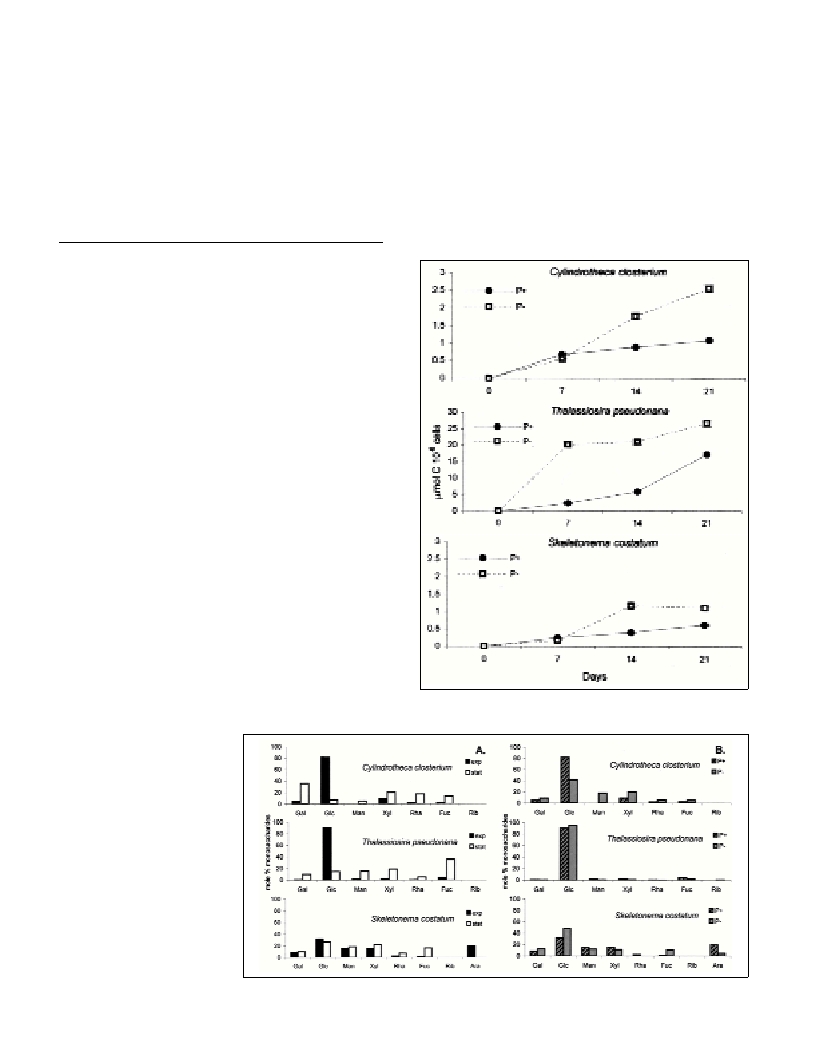Rapp. Comm. int. Mer Médit., 37,2004
279
EXTRACELLULAR CARBOHYDRATES RELEASED BY P-LIMITED DIATOMS
Erika Magaletti
1*
, Ranieri Urbani
2
, Paola Sist
2
and Anna Maria Cicero
1
1
ICRAM, via di Casalotti, 300, 00166 Roma, Italy
2
University of Trieste, Department of Biochemistry, Biophysics and Macromolecular Chemistry,
via L. Giorgieri, 1, I 34127 Trieste, Italy - * e.magaletti@icram.org
Abstract
A laboratory study was performed on the extracellular production of carbohydrates by the marine diatoms Cylindrotheca closterium,
Thalassiosira pseudonanaand Skeletonema costatum to investigate the role of P-limitation and growth status on abundance and chemical
characteristics of the released polysaccharides. Inorganic phosphorus depletion caused an increase of total polysaccharides in all species
and a reduction in the molar percentage of glucose. Maximum exopolysaccharide production was found at the transition stage between
exponential and stationary growth phase.
Key-words: Diatoms, exopolysaccharides, mucilage, phosphorus
Cultures of the marine diatoms Thalassiosira pseudonanaHasle &
Heimdal, Skeletonema costatum(Greville) Cleve and Cylindrotheca
closterium (Ehrenberg) Lewin & Reimann,were isolated from the
Northern Adriatic and maintained in f/2 medium at 18°C, 16:8 h
light:dark cycle, 112
?
Em
-2
s
-1
irradiance. Cells were treated with an
antibiotic mix [1] for 24 h. P-replete (P+; 36
µ
M of P-PO
4
) and P-
deplete treatments (P-; 6
µ
M of P-PO
4
) were established for each
species in duplicate ?asks.
Cells were enumerated using a Bürker counting chamber and light
microscopy. Nutrient concentrations were determined spectrophoto-
metrically [2], extracellular carbohydrates and aldoses composition
were determined colorimetrically [3] and by gas-chromatography [4],
respectively.
The production of total exopolysaccharides was significantly higher
under the P-depleted condition (P-) compared to the P-replete
condition (P+) (Fig. 1.). Maximum carbohydrate concentrations were
found in T. pseudonana(26.8
µ
mol C/10
6
cells). The aldose signature
varied according to growth status (Fig. 2A). Glucose was generally
the most abundant monomer during the exponential growth phase. In
the stationary growth, the percentage of glucose decreased and
galactose, mannose, xylose, rhamnose and fucose increased. Changes
in aldoses were most pronounced in C. closterium (Fig. 2B).
The diatom species investigated are commonly foundin the Northern
Adriatic Sea [5]. Species-specific differences in abundance and che-
mical characteristics of the exudates may have an important impact on
the degradability of the exudates, thus in?uencing the dynamics of
organic matter in coastal waters [6].
References
1-Guerrini F., Mazzotti A., Boni L., Pistocchi R., 1998. Bacterial-algal
interactions in polysaccharide production. Aquat. Microb. Ecol., 15: 247-
253.
2-Strickland J.D.H., and Parsons T.R., 1972. A practical handbook of
seawater analysis, 2
nd
edition. Bull. Fish. Res. Bd. Can.
3-Myklestad S., Skanoy E., and Hestmann S., 1997. A sensitive and rapid
method for analysis of dissolved mono- and polysaccharides in seawater.
Mar. Chem., 56: 279-286.
4-Blakeney A.B., Harris P.J., Henry R.J. and Stone B.A., 1983. A simple
and rapid preparation of alditol
acetates for monosaccharide ana-
lysis. Carbohyd. Res.,113: 291-299.
5-Regione Emilia Romagna-ARPA,
Struttura Oceanografica Daphne,
2002. Eutrofizzazione delle acque
costiere dell’Emilia Romagna,
Rapporto 2002. P. 200.
6-Puddu A., Zoppini A., Fazi S.,
Rosati M., Amalfitano S., and
Magaletti E., 2003. Bacterial uptake
of DOM released from P-limited
phytoplankton. FEMS Microbiol.
Ecol. (In press).
Fig. 1. Temporal variation of total extracellular carbohydrates (
µ
mol
C/106 cells) in batch cultures of three diatom species. P+: P-replete;
P: P-depleted.
Fig. 2. Aldoses composition of dissolved extracellular carbohydrates released by three diatom species under
different growth stages (A.) and nutrient conditions (B.).

